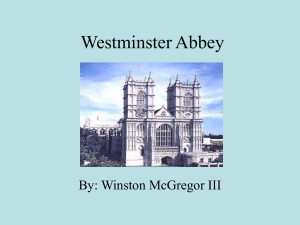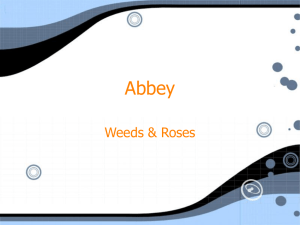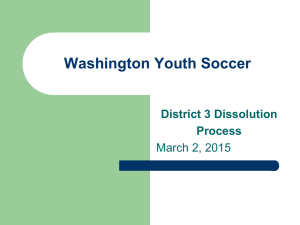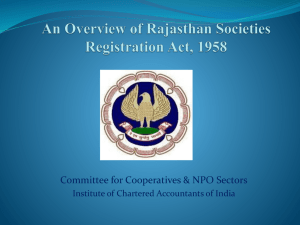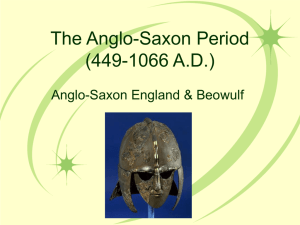PPT: Dissolution of the Monasteries
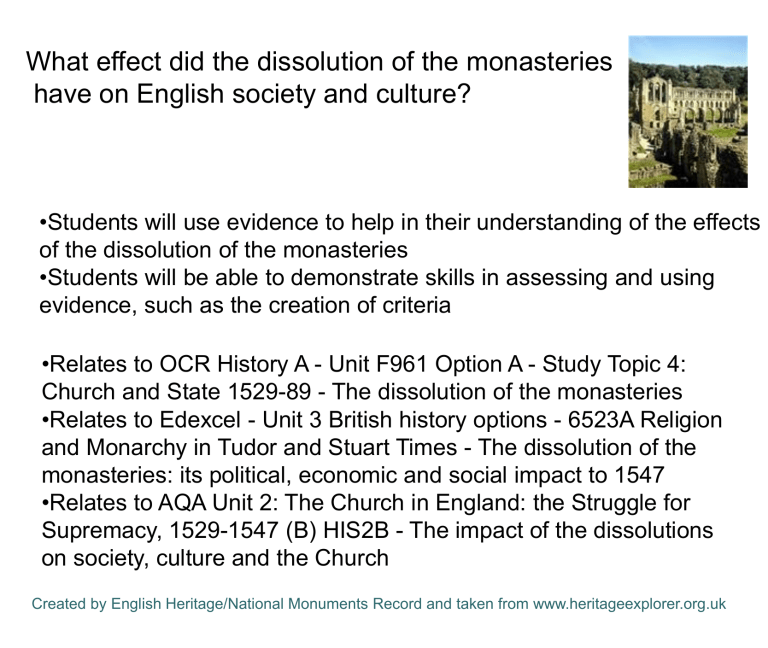
What effect did the dissolution of the monasteries have on English society and culture?
•Students will use evidence to help in their understanding of the effects of the dissolution of the monasteries
•Students will be able to demonstrate skills in assessing and using evidence, such as the creation of criteria
•Relates to OCR History A - Unit F961 Option A - Study Topic 4:
Church and State 1529-89 - The dissolution of the monasteries
•Relates to Edexcel - Unit 3 British history options - 6523A Religion and Monarchy in Tudor and Stuart Times - The dissolution of the monasteries: its political, economic and social impact to 1547
•Relates to AQA Unit 2: The Church in England: the Struggle for
Supremacy, 1529-1547 (B) HIS2B - The impact of the dissolutions on society, culture and the Church
Created by English Heritage/National Monuments Record and taken from www.heritageexplorer.org.uk
What effect did the dissolution of the monasteries have on British society?
The dissolution of the monasteries happened between 1536 and 1540; a remarkably short period of time.
The buildings were abandoned and the monks dispersed.
But how did it happen?
What happened next?
What effect did this have nationally and locally?
Who gained and who lost out?
What effect did the dissolution of the monasteries have on British society?
What remains of Roche Abbey today
There were over 800 monasteries before the dissolution
All were eventually closed but suffered different fates.
Each has a story to tell ......
Start by reading the story of what happened at Roche Abbey in Yorkshire.
We have a very detailed contemporary account of the events that followed the surrender of the monastery which is unique.
However the actual sequence of events that the abbey went through is probably fairly typical. The account gives us both an insight into the dissolution process and a rare glimpse into the thoughts and issues of local people caught up in them.
Account of the spoilation of Roche Abbey
What effect did the dissolution of the monasteries have on British society?
What remains of Roche Abbey today
Complete the table on the next slide putting the events that happened at Roche into order
What effect did the dissolution of the monasteries have on British society?
Steps in the dissolution of Roche Abbey
Step 1 Abbot Henry Cundall of Roche and his seventeen monks gather in the chapter-house at Roche on 23 June 1538, and sign the surrender deed
Step 2
What effect did the dissolution of the monasteries have on British society?
What can you learn from this account about the intentions of Thomas Cromwell?
What evidence does the account provide for the way that people regarded their local monastery and the
Roman Catholic church?
Is there anything that the account does not tell us?
What effect did the dissolution of the monasteries have on British society?
Look at the images of monasteries on the next slides and use the information in the captions to find out what happened to each of them after the Dissolution.
Use this information to start filling in the table on the effects of dissolution - you need to choose which category to put each effect in
The table is on the next slide and also available to download
Effects of the dissolution of the monasteries on buildings/landscape/heritage (cultural effects) on the poor, sick, travellers and education (social effects) on the gentry, large landowners and society on churches, cathedrals and monks
Fountains Abbey, North
Yorkshire
An aerial view of Fountains Abbey. This Cistercian monastery was founded in
1132 by a group of monks from the Benedictine house of St Mary’s, York.
They wanted to pursue a harsher and more disciplined way of monastic life.
During the Middle Ages Fountains was one of the leading Cistercian monasteries. It gave help to a number of needy people who came to the abbey gates during the famine of 1194-6. By the time of the Dissolution it was the richest Cistercian abbey in Britain, valued at £1115 18s 2d. It was closed in November 1539. The abbot and 30 monks all received pensions.
Demolition began in 1540. The new owner, Sir Richard Gresham, stripped it of anything of value. Furnaces were built in the church to melt the lead from the roof and pipes. The fire was fed by timber from the screens and furnishings.
He did not demolish all the buildings as he planned to convert them into a mansion. The grounds surrounding the ruin were landscaped during the 18th century. It is now (2011) a World Heritage Site.
Bayham Old Abbey, Lamberhurst,
Kent
This aerial view shows the ruins of Bayham Abbey with New Bayham Abbey beyond. The original abbey of the Premonstratensians or White canons (monks) was founded in the early 13th century. It sat right on the border of Kent and Sussex and had 2 gatehouses, one for each county. In 1525 the abbey was dissolved by
Cardinal Wolsey to create funds for Wolsey's college foundations at Oxford and
Ipswich. Around 1800 the ruins became a picturesque feature of the landscaped grounds of New Bayham Abbey based on the ideas of landscape designer
Humphrey Repton . This site is now (2011) in the care of English Heritage.
Kirkstall Abbey, Kirkstall,
Leeds, West Yorkshire
Kirkstall Abbey was founded in 1152 by a community of Cistercian monks from
Fountains Abbey. It gained its wealth from keeping sheep for the wool trade.
Monastic life for the 31 monks came to an end in November 1540 when the abbey was surrendered to Henry VIII as part of the dissolution of the monasteries Although a few buildings were cleared to ground level most were left standing and used for agricultural purposes. This is perhaps why Kirkstall is now the most complete set of
Cistercian ruins in Britain. The church still stands to roof level. In the late 18th and early 19th centuries the road from Leeds to Skipton ran right through the nave ! The abbey is now in the care of Leeds City Council (2011).
Thetford Priory, Abbey House
Grounds, Thetford, Norfolk
These are the remains of The Cluniac Priory of Our Lady of Thetford. It was founded in 1103-4 by Roger Bigod, on the south side of the river Little Ouse. It was dependent on Lewes priory until 1114. In 1114 it moved to its present site here, on the north of the river. It was closed as part of the Dissolution in 1540. It was the burial place of the earls and dukes of Norfolk for 400 years. When the priory was closed their remains were moved to Framlingham church, close to their family seat,
Framlingham castle. The ruins include the gatehouse, cloisters, prior's house, lady chapel and infirmary. This property is now in the care of English Heritage (2010).
Read official list description.
St Marys Chapel, Glastonbury
Abbey, Glastonbury, Somerset
Glastonbury is by tradition the oldest monastic foundation in England. It is believed to contain the burial place of King
Arthur. Little is known of the monastery until
940 when it was refounded as a
Benedictine Abbey by St Dunstan. The standing remains belong to the great abbey church rebuilt after a disastrous fire in 1184.
The abbey was dissolved in 1539 after the abbot Richard Whyting and 2 of his monks had been executed on top of Glastonbury
Tor for alleged treason. This view shows the ruins of St Mary's Chapel with the walls supported with props to stop them from falling down.
Furness Abbey, Barrow in
Furness, Cumbria
St Mary of Furness was founded in 1123 by Stephen who became King of
England. By Tudor times it was the second richest Cistercian house in
England. The surrender of Furness abbey in 1537 was a turning point in the dissolution. The abbot and monks gave some support to the Pilgrimage of
Grace, speaking out against the King. They were afraid that they might be executed and so decided to surrender the abbey voluntarily. This then became the pattern for other monasteries and made it easier to close them quickly. In
1539 the abbey and its land was granted to Henry VIII's first minister, Thomas
Cromwell. In 1923 the abbey was put into the care of the Office of Works by the
Cavendish family. It is now in the care of English Heritage (2010).
Read Official List Description
Malmesbury Abbey,
Wiltshire
A nunnery was first documented here in 603. A monastery was founded during the abbacy of Aldhelm (c675-705). It became Benedictine in the reign of Edgar
(959 –975) and remained so until dissolved in 1539. The final Abbey Church was built circa 1160-70 and had 13th/14th and 15th century additions. The 431 feet (131m) tall spire, collapsed in a storm around 1500. The west tower fell around 1550. As a result of these two collapses, less than half of the original building stands today. The abbey was closed at the Dissolution of the
Monasteries in 1539 by Henry VIII. It was sold, with all its lands, to William
Stumpe, a rich merchant. He gave the abbey church to the town for continuing use as a parish church and filled the abbey buildings with twenty looms for his cloth-weaving enterprise.
Read official list description
Priory of St Pancras,
Cockshut Road, Lewes,
East Sussex
These are the ruins of the Priory of St Pancras. The priory was founded after
1077 by William de Warenne, the 1st Earl of Surrey. The site was purchased after the dissolution by King Henry VIII's chief minister, Thomas Cromwell. In
1537-38 he had it professionally dismantled by a team of men brought in from
London.
Read official list description.
Cathedral Church of St Augustine,
Bristol
St Augustine's Abbey was founded in 1140 by Robert Fitzhardinge, a Bristol burgess.
In 1542 it was one of the 6 monastery churches designated as Cathedrals by Henry
VIII after the dissolution. The others were, Chester, Gloucester, Oxford, Peterborough and Westminster .
Reconstruction Drawing,
Hailes Abbey,
Gloucestershire
The Cistercian abbey of Hailes was founded in 1246 by Richard, Earl of Cornwall.
He founded it in thanksgiving for surviving a shipwreck. Its elaborate buildings were funded by pilgrims visiting its relic, the 'Holy Blood of Hailes', a phial allegedly of
Christ's blood. The abbey church was built by 1277. Following its dissolution in
1539 by Henry VIII, the abbey was sold to a dealer in monastic properties, soon after which the church was demolished. This site is now in the care of English
Heritage (2010).
Reading Abbey Ruins,
Abbey Walk, Reading
This Cluniac Abbey was founded in 1121 by Henry I and was his favourite monastery He was buried here. Reading was the only Cluniac house to be granted abbey status. Most of the stone has been removed since the dissolution . Much of it can be found built into walls all over Reading and several cart-loads of carved stones are in the Forbury Gardens near by.
Read official list description
Newstead Abbey, Ravenshead,
Nottinghamshire
An Augustinian Priory was established circa 1170 by Henry III. It was extended and rebuilt in the late 13th century with the Prior's Lodgings, Great Hall and Dorter added in the 15th century. The monastery was dissolved in 1539. In the following year Henry VIII granted Newstead to Sir John Byron. He converted the priory into a country house for his family. The poet, Lord Byron, inherited the house in 1798.
Newstead was sold to the Nottinghamshire philanthropist Sir Julien Cahn. He presented it to Nottingham Corporation in 1931. Many of the monastic buildings survive intact in the adjoining mansion which is used as a museum.
New Inn, Gloucester,
Gloucestershire
This inn was originally a large hostelry built for the former Benedictine Abbey of St
Peter. It was built by John Twyning, a monk of the abbey . It is on the site of an even earlier inn. It was built in c1451. At the dissolution of the abbey the inn passed to the
Dean and Chapter of Gloucester Cathedral. It was leased to various inn holders until it was sold in 1858. The building is the most complete surviving example of a medieval courtyard inn with galleries.
Read official list description
Abbey of St Agatha,
Easby, North
Yorkshire
These are the standing remains of the Premonstratensian Abbey of St Agatha at
Easby. The abbey was founded by Roald, Constable of Richmond Castle in 1155.
It was suppressed (closed) in 1536. It comprises a church with cloister, sacristies, chapter house, refectory , dorter , guests' solar, reredorter and abbot's accommodation. There was a hospital attached to the abbey for 22 poor men.
This site is now in the care of English Heritage (2010).
Read official list description.
Remains of Birkenhead
Priory, Birkenhead,
Merseyside
The Priory was founded in 1150 by Hamo de Massey as a Benedictine House for sixteen Benedictine (Black) monks and built in several phases up to 1400. It was sited on an isolated headland on the Wirral, bounded by Wallasey Pool, the
Mersey Estuary and Tranmere Pool. It is now surrounded by shipyard dry docks.
The priory served as accommodation for travellers using the ferry across the
River Mersey. It was dissolved in 1536 and the estate passed into the hands of
Ralph Worsley of Lancashire. After the buildings fell into ruins, the chapter house chapel survived as a place of worship. Services were later held in the adjoining St
Mary's parish church. The remains were restored in 1896 when they became the property of Birkenhead Corporation .
Read official list description.
What effect did the dissolution of the monasteries have on British society?
You have now seen 15 examples of monasteries and noted the effects of what happened to them.
But how typical was their experience and what happened in the area where you live?
You can find out about local examples by searching on Heritage Explorer
Go to the search page and enter the keywords monastery, dissolution
Click on the 'where' bar, select your own county from the drop down menu and click
Search
If your county is small or returns very few results then choose another, nearby county
Add information about these monasteries to your table
Your table may now look something like this
Effects of the dissolution of the monasteries on buildings/landscape/heritage (cultural effects) on the poor, sick, travellers and education (social effects)
Many monasteries became ruins and are now tourist attractions
Monasteries no longer provided accommodation for travellers on the gentry, large landowners and society on churches, cathedrals and monks
Many younger sons of the gentry were able to buy property
Six new cathedrals were created
What effect did the dissolution of the monasteries have on British society?
Look through your tables and discuss as a class or group what effects it is quite easy to find evidence about and which are more difficult. Why is this?
For each category think about what effect that outcome would have had on the local area and nationally; short and long term, who were the winners and losers?
Historians have long debated the effects of the closure of monasteries on society. Older, often Catholic, historians believed that the dissolution lead to increased unemployment and poverty and ultimately to the creation of the
Elizabethan Poor Law. Contemporary historians disagree arguing that the closure of monasteries may have made some problems worse but did not create them.
Can you use evidence from your table to decide who you agree with? Is there anything else we would need to know?
What effect did the dissolution of the monasteries have on British society?
Extension work 1
Further questions for discussion or essay writing
•·What determined the fate of individual monasteries?
•·Can this information tell us more about why the dissolution met with little or no local opposition?
What effect did the dissolution of the monasteries have on British society?
Extension work 2
Choose one or two local monasteries and look at what happened to them in detail -
·
·
· use the information as a case study how typical is the pattern of dissolution? what were the effects in that locality? how does this fit in with the historical debate on the effects of dissolution?
Use this website find out about using archive sources to study an individual monastery. The National Archives - The Dissolution of the Monasteries and
Chantries
Alternatively you can find very detailed information on the dissolution of 5 monasteries on this website Cistercians in Yorkshire
